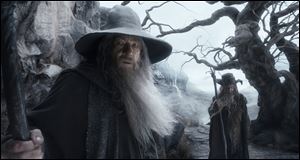
‘Hobbit: The Desolation of Smaug’ needs to lighten up, have fun
12/12/2013
Ian McKellen in a scene from "The Hobbit: The Desolation of Smaug."
The Hobbit: The Desolation of Smaug is Peter Jackson at his directorial worst and best.
Like its predecessor, the second installment of The Hobbit trilogy is too long, too ambitious, and too dark — remember, this is based on a beloved children’s story. It’s also unfocused, occasionally undisciplined, and routinely suffers from pacing issues.
Then there are those magical Middle-earth moments in The Desolation of Smaug — epic battles between heroes and beasts — that few directors other than Jackson can successfully conjure onscreen.
If only there weren’t such wide gulfs of tedium and painful adherence to book details between such inspired moments.
The film is the middle part in the perilous quest of a dozen dwarves, the Hobbit Bilbo Baggins, and the wizard Gandalf the Grey to reclaim a kingdom of riches guarded by the towering and menacing dragon Smaug. In this part of the adventure, they’ll battle giant spiders, elves, orcs, meet the downtrodden human residents of Lake-town, and encounter the fiery wrath of Smaug.
But before the movie rejoins their exploits, Jackson opts to explain how this adventure came to be in a five-minute backstory of Thorin Oakenshield (Richard Armitage), the future Dwarven king. It’s a historical aside with no bearing on the present-tense of the story, yet this out-of-place and ponderous sequence will no doubt appeal to the Tolkien faithful. Consider it a microcosm to Jackson’s Hobbit trilogy so far: a franchise geared for fantasy fans but lacking the ability to connect with the mainstream audiences, particularly children, who are more likely able to name Snow White’s dwarves than those in the film.
Directed by Peter Jackson. Written by Fran Walsh, Philippa Boyens, Jackson, and Guillermo del Toro. A Warner Brothers/New Line/MGM release, playing at Cinemark Franklin Park, Fallen Timbers, and Levis Commons. Rated PG-13 for extended sequences of intense fantasy action violence and frightening images. Running time: 159 minutes.
Critic’s rating: **½
Cast: Martin Freeman, Richard Armitage, Ian McKellen, Evangeline Lilly, Luke Evans, James Orlando Bloom, Stephen Fry
Jackson’s determination in manufacturing deeper context to every motivation and event causes him to lose his grip on the main story and the characters.
Martin Freeman as Bilbo scarcely resonates — it’s difficult to recall one stand-out moment for the main hero of the story. And Benedict Cumberbatch as the voice of Smaug is full of fire-breathing fury and menace, but he never brings much personality to the dragon other than a greedy grump.
The wonderful interaction between Bilbo and Smaug from the book is lost in the cavernous halls of the lost Dwarf Kingdom of Erebor. The book was all about this moment, but in the course this convoluted film series, Smaug is an afterthought, reduced to competing for screen time with an army of characters expanded to include the return of Sauron and his ferocious legion of orcs.
The Lord of the Rings was conceived and written as a balance between intertwining stories, whereas the Hobbit was more simplistic and linear in structure. Jackson pulled off the former trilogy with aplomb, but the latter he has overplayed, at least so far, propping up its point A to point Z story line with far too many distractions, introductions, and reunions. Shoehorned into the story, for instance, is a romantic subplot between Legolas (Orlando Bloom) and fellow Wood-elf Tauriel (Evangeline Lilly), who is developing feelings for the surprisingly handsome dwarf Kili (Aidan Turner). None of that is in The Hobbit, and it certainly doesn’t need to be in the film.
Once again, Jackson meanders from one plot crisis to the next, with helicopter shots of bucolic New Zealand as the bridge between the chaos. It’s such a predictable rhythm, that it begs a drinking game: Chug a beer every time the film turns into a tourist booster for New Zealand travel.
What saves this rather bloated mess is Jackson’s ability to still muster a sense of wonder and fun from the main story. The intricate battle sequence between dwarves riding in barrels roaring down the rapids, and elves and orcs rushing to keep up on river banks, rivals any cinematic achievement in The Lord of the Rings trilogy. During such occasions, the weight of the film’s heavy-handed plot is lifted, as it zips along in breakneck fashion.
Those are the moments to cling to, even as the film wanders from its course.
After rewatching The Hobbit: An Unexpected Journey a few months ago, I found myself more enchanted with the film — a peculiar reaction, given that the movies were made for the big screen and should lose much of their wonder and marvel in the transition to the home. In this instance, the smaller appearance equaled smaller expectations. Perhaps this is to be the fate of The Desolation of Smaug and the Hobbit trilogy: big-budget movies made more intimate and accessible and all-around better on DVD and Blu-ray.
Contact Kirk Baird at kbaird@theblade.com or 419-724-6734.